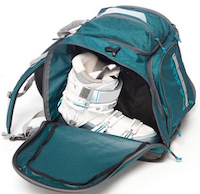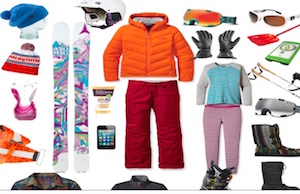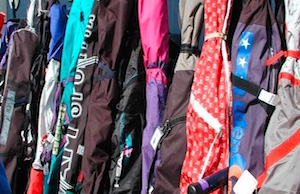By WILL MCGOUGH for OnTheSnow.com
Let’s face it, ski travel can be expensive—and we’re not even talking about lift tickets, lessons and lodging. The process of getting to your ski destination with your gear often involves flying, checking bags, renting a car and shelling out a lot of money. We’re here to help you navigate this daunting and often times expensive process.
We’ve put together a guide to help you navigate airline policies pertaining to ski and snowboard gear, things you’ll want to know when picking an airline and packing your equipment. We’ve also provided tips for traveling efficiently, saving money on baggage fees and rental cars, as well as insight on whether or not you should forget the whole thing and just ship your stuff.
 A few things of note regarding airline policies: Boots in a “boot bag” never count as a piece of checked luggage, so long as they accompany a pair of skis or a snowboard and the bag contains only boots.
A few things of note regarding airline policies: Boots in a “boot bag” never count as a piece of checked luggage, so long as they accompany a pair of skis or a snowboard and the bag contains only boots.
Skis and snowboard bags are subject to the same set of rules across the board, meaning that they are not treated differently and are always a single piece of luggage assuming they follow the airline’s specific and individual regulations.
Flying with Skis or Snowboards
- As you’ll see, airlines do differ in their size and weight restrictions, as well as in the cost of checking a bag. As with any other piece of luggage, the price to check your equipment depends on the airline and no airline has a specific ski or snowboard fee.
American
One pair of skis/snowboard and one boot bag containing only boots/bindings will be treated as a single item with the applicable checked bag charge ($25 for the first bag and $35 for the second, unless you have reached a certain status with the airline or have another means of waiving bag fees, such as an airline credit card).
Boot bags must not contain other items or exceed 45 linear inches (length + width + height) to be grouped as a single item with skis/snowboard. Boot bags that contain other articles will be subject to the excess baggage charge for a single piece.
Skis and snowboards up to 126 inches (320 cm) are allowed without an oversized fee.
Southwest
Southwest Airlines allows up to two bags (containing one set of snow skis, ski poles and ski boots) to count as one item, even if they are packed and tagged separately (one ski bag and one boot bag). Skis, poles and snowboards must be encased in an appropriate container.
Since Southwest gives you two free bags, you can avoid all baggage fees even if you check your clothes.
Delta
A ski bag or one snowboard bag and one boot bag is accepted per person and counts as one checked bag.
The combined weight of the ski/snowboard bag and the boot bag may not exceed 50 lbs. or excess weight charges will apply, however no excess size charges are applicable. All standard baggage charges apply, meaning it is $25 for the first bag and $40 for the second, unless you have a means of waiving bag fees.
United
United accepts one item of ski equipment per customer as checked baggage, either one snowboard or one ski bag (containing up to two sets of skis and poles) to go along with a boot bag.
Ski and boot bags must be less than 50 lbs. to avoid overweight charges. Service charges apply whenever bags are checked and are determined by the marketing carrier. Ski equipment in addition to the baggage allowance will be assessed at the excess baggage charge.
Ski equipment must be securely encased in a suitable container, and United is not liable for damage to ski and snowboard equipment.
Frontier
Skis (or snowboard), ski poles and ski boots all count as one checked bag. A pair of boots may be checked separate from the ski bag so long as it does not exceed 25 lbs. (if it does, it will be considered a separate bag). For example, one piece of luggage, one ski bag and a boot bag less than 25 lbs. equals two items, but a piece of luggage, one ski bag and one boot bag over 25 lbs. would equal three.
Oversize charges do not apply, but overweight charges will be assessed for a bag over 50 lbs.
Air Canada
One or more sets of skis and poles carried together in the same container count as one piece of checked baggage (ski poles that are carried separately will count as a piece of checked baggage, so make sure you pack them in with the skis). Skis and poles must be packed in a rigid and/or hard shell case specifically designed for shipping. The policies for a snowboard are the same. There are no oversize charges for skis or snowboards, but overweight charges will apply (must be less than 50 lbs.).
If your baggage count (sports equipment plus number of other bags to be checked) exceeds the maximum number of items allowed by your fare type, additional checked baggage charges will apply.
Traveling with Gear
Get Your Money Back: Be sure to check with your hotel to see if they offer any reimbursements for costs associated with ski and snowboard gear or baggage fees in general. Some hotels offer “checked bag credits” in the form of a discount at the hotel to help guests cover the costs of traveling with their gear.
 Be Realistic: We know you’ll look good in that dress or those slacks, but will you really wear them? Mountain towns are typically very casual (and cold), and there’s no reason to lug around three pairs of shoes. For a long weekend trip, you can probably get away with wearing the jeans you wore on the plane to most dinners. Ditch the elaborate wardrobe in favor of practical and recyclable clothes.
Be Realistic: We know you’ll look good in that dress or those slacks, but will you really wear them? Mountain towns are typically very casual (and cold), and there’s no reason to lug around three pairs of shoes. For a long weekend trip, you can probably get away with wearing the jeans you wore on the plane to most dinners. Ditch the elaborate wardrobe in favor of practical and recyclable clothes.
Don’t Believe Your Eyes: It sure looks bulky hanging there in your closet, but most snow gear is very light and moldable. Slowly fold jackets and pants, being sure to squeeze out all of the air. Pants can be rolled into the size of a coffee can and jackets can be folded down significantly. One trick: fold the jacket a few days before and put your suitcase on top of it. This will allow all the air to escape over time and prevent it from rising back up once placed in your suitcase.
Test the Waters: Airlines say you can’t have any additional items other than boots in your boot bag, but somehow we doubt they’re going to put up a fight if you have socks in there too. Most times you’ll probably get through without a problem, and in the case they do give you trouble, socks (and other small items such as gloves) can easily be transferred into another piece of luggage at the counter. You can save yourself some space in the suitcase if you’re trying to carry on. If you get busted, well, at least you tried!
Fill Your Ski Bag to the Max: Boot bags aren’t allowed to contain anything else, but ski bags are fair game for extra items. Put as much of the little things in with your skis as you can—hats, gloves, socks—all the small things that would bulk up a small suitcase. If you put your jacket in the ski bag instead of your suitcase, fill the pockets with the above items to take advantage of unused space (but leave the pockets empty if you’re putting it in your suitcase. Filling the pockets will add bulk and prevent it from flattening out).
See if You Can Rent for Free: Some destinations/hotels offer free or discounted rentals when you book lodging, so be sure to check around for coupons.
Should I Ship My Gear?
We’ve seen all the options for flying with gear, but what about shipping options? Showing up and having the gear already at the hotel is extremely convenient, but it is significantly more expensive and you obviously have to pack it all up at least a week in advance of your trip.
Luggage Forward charges $84 for a pair of skis or a snowboard and $119 for two pairs of skis or two snowboards one way within the United States. There are weight restrictions as well (25 lbs. for one and 40 lbs. for two), and the prices above are only the basic shipping. Other add-ons, such as precise pickup times and priority shipping, will tack on even more.
Less hassle, but more cash. Such is life!
For car rental insider tips, click here
By Will McGough https://www.onthesnow.com/news/a/584562/insider-tips-for-ski—snowboard-travel




